.jpg)
Installation view, Phyllida Barlow. Unscripted, Hauser & Wirth Somerset, 2024. © Phyllida Barlow Estate. Courtesy Phyllida Barlow Estate and Hauser & Wirth. Photo: Ken Adlard.
Hauser & Wirth Somerset
25 May 2024 – 5 January 2025
by WILL JENNINGS
There is something ghostly going on. At the front of Hauser & Wirth Somerset’s Bruton location, two large Phyllida Barlow sculptures signal arrival at Unscripted, a posthumous exhibition of the artist’s work. Untitled: Megaphone and Untitled: Stacked Chairs were both made in 2014 for GIG, Barlow’s solo exhibition that opened the farmyard campus, though they were then in a different arrangement – the seats in Stacked Chairs were pushed together as if swept up after some event, whereas now they are bursting from the grainstore. It is a foreshadow of Frances Morris’s presentation that, while the curation of Unscripted leans into Barlow’s previous exhibition, there is space for recontextualisation and reimagination rather than a repeat.
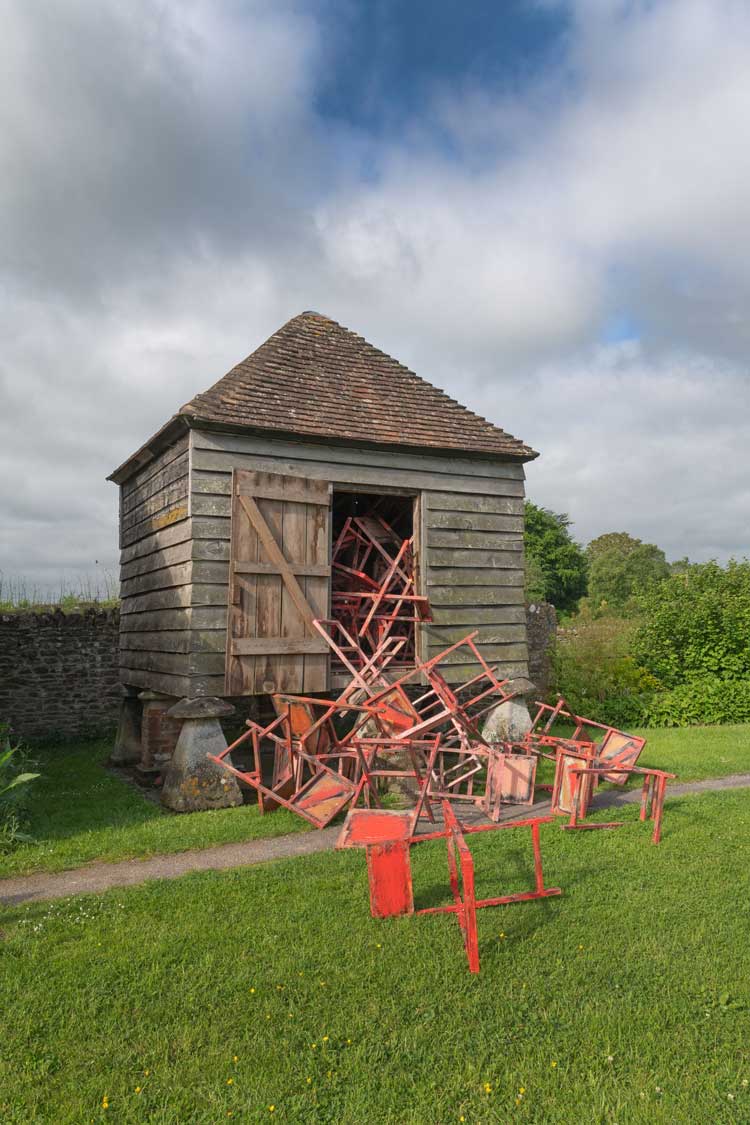
Untitled: Stacked Chairs, 2014. Installation view, Phyllida Barlow. Unscripted, Hauser & Wirth Somerset, 2024. © Phyllida Barlow Estate. Courtesy Phyllida Barlow Estate and Hauser & Wirth. Photo: Ken Adlard.
“There's nothing here that is a copy of any show she made,” Morris says, adding: “We could have made a facsimile of GIG [but] we’ve got to find ways of understanding and deepening our relationship with work if it’s going to survive.” Elements of it are present, however, alongside fragments of other seminal Barlow installations – including 2014’s Dock, which filled Tate Britain, and Folly, the assemblage squeezed into the British Pavilion at the 2017 Venice Biennale, which Morris has collaged into an intense central gallery. Morris hopes that reworked, repaired and reconfigured, these extracts might open new dialogue rather than repeat a script from another time.
.jpg)
Untitled: Megaphone, 2014. Steel, timber, plywood, wirenetting, sand, polyurethane foam, polystyrene, paint, varnish, 600 x 235 x 290 cm. Installation view, Phyllida Barlow. Unscripted, Hauser & Wirth Somerset, 2024. © Phyllida Barlow Estate. Courtesy Phyllida Barlow Estate and Hauser & Wirth. Photo: Ken Adlard.
However, it starts at a smaller scale. Five wrapped bundles sit atop a bookshop shelf, almost missable by any visitor headed towards the exhibition entrance. They read as soft, oversized balls, but Barlow’s work is an interplay of truth and deceit, revealing and concealing. One, for example, is a large lump of dough wrapped in silver foil, another’s guts are timber and newspaper enclosed in fabric. These are concealed interiors.
.jpg)
Installation view, Phyllida Barlow. Unscripted, Hauser & Wirth Somerset, 2024. © Phyllida Barlow Estate. Courtesy Phyllida Barlow Estate and Hauser & Wirth. Photo: Ken Adlard.
“Although Phyllida's works look incredibly tough, she used crappy old materials a lot of the time,” Morris says as she stands in the opening gallery of Unscripted. Around her are six discrete works unashamedly made of what the artworld romantically terms “found objects”, but most would call “junk”. There is a stratified column of cardboard, foam, felt and plywood, and a two-metre square cube of ripped and entangled canvases. A jagged collection of steel wedges appears to puncture the gallery floor, chaotically coated with PVA, paint, polyurethane foam, spray paint, sand and paint stripper. Barlow threw everything at her works, and then some more. Morris smiles: “She was great with the cheapest, most horrible stuff.”
In less capable hands, these composite ingredients may look barely dissimilar to how they looked in the skips or from the piles of urban fly-tipping from which they were plucked, but Barlow made them sing with transfiguration, knowingly drawing from and referencing modern art histories. These pieces selected by Morris speak not only to Barlow’s playful appropriation of junk, but also to creative conversations with the work of artists she adored, studied and drew inspiration from.
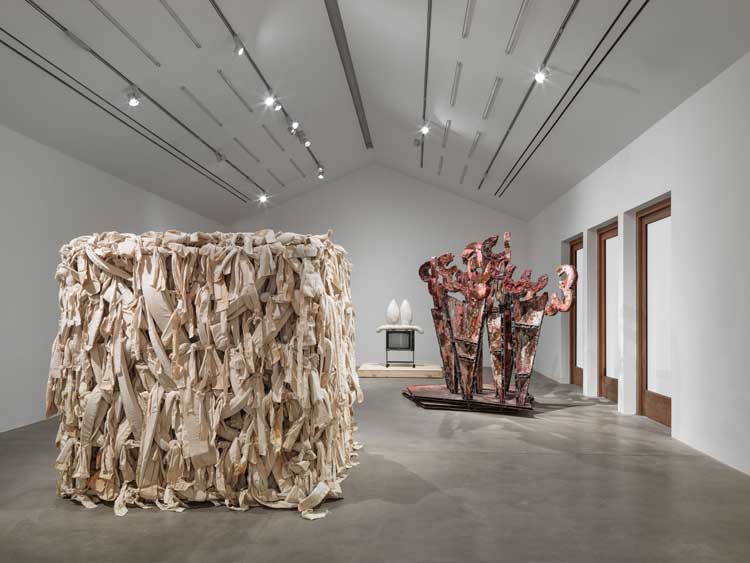
Left: Shedmesh. Installation view, Phyllida Barlow. Unscripted, Hauser & Wirth Somerset, 2024. © Phyllida Barlow Estate. Courtesy Phyllida Barlow Estate and Hauser & Wirth. Photo: Ken Adlard.
For example, the ragged cube Shedmesh was made for a 1975 exhibition at Camden Art Centre and speaks to a work by Tony Smith that Barlow admired. At a distance, it reads like a white cube. Up close, the openings between the torn canvas show glimpses of structural innards, revealing a veritas of form and making. Barlow seemed to take pleasure in roughing up the neatness of modernist geometry, also witnessed in her column of sliced matter which twists an architectural expectation of stone or marble into something altogether more abrasive. Throughout, there are sideways glances and direct quotations of others – Hans Arp, Marcel Duchamp, Salvador Dalí, Joan Miró and Eduardo Chillida – though Morris says you do not need to read these connections to enjoy Barlow’s work, but “you can see them if you know your art history”.
The main gallery brings the kind of Barlow hang with which most people will be familiar. A visual cacophony of suspended boulders, overhanging slabs of concrete, rags and charred timber piled up like a pyre, towering intestinal pipes that seem to rise from, then return to, the concrete floor, and stacks of boulders teetering on the edge of cataclysm. This is a collage of works Barlow made for different installations, carefully repaired and repositioned into new relationships while retaining some of Barlow’s intended experiential qualities.
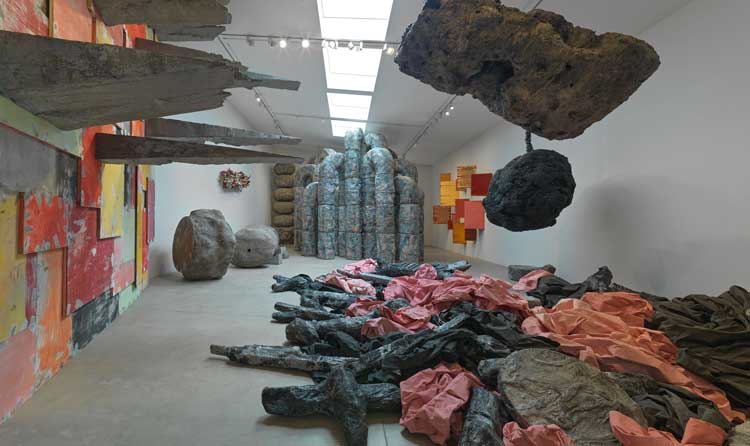
Installation view, Phyllida Barlow. Unscripted, Hauser & Wirth Somerset, 2024. © Phyllida Barlow Estate. Courtesy Phyllida Barlow Estate and Hauser & Wirth. Photo: Ken Adlard.
That pile of boulders in the corner, for example, was made for the 2017 British Pavilion, where it held a similar visual position deep in the space on entry. The large colourfield wall with concrete-esque awnings was also at Venice, blocking the doorway as it does here. Barlow was, above all, a master of spatial management, contorting the body and eye to the whim of her works through a language as much theatre as form.
Those boulders hanging from the ceiling are slapstick. Formed of wire netting, polystyrene and expanding foam – as if Acme did art – they look solid, but this is an instance of the artist concealing not showing. Similarly, the concrete-like awning overhangs are lightweight props that deceive enough to introduce a sense of anxiety, but delight enough in cartoon-like play to relieve the tension at once. On entering the gallery, it is made deliberately easy to see behind the wall that holds them up. Here, we see the insides and read a matrix of gubbins and struts holding the whole thing upright. Sometimes Barlow wanted to let us in, sometimes she kept the truth withdrawn.
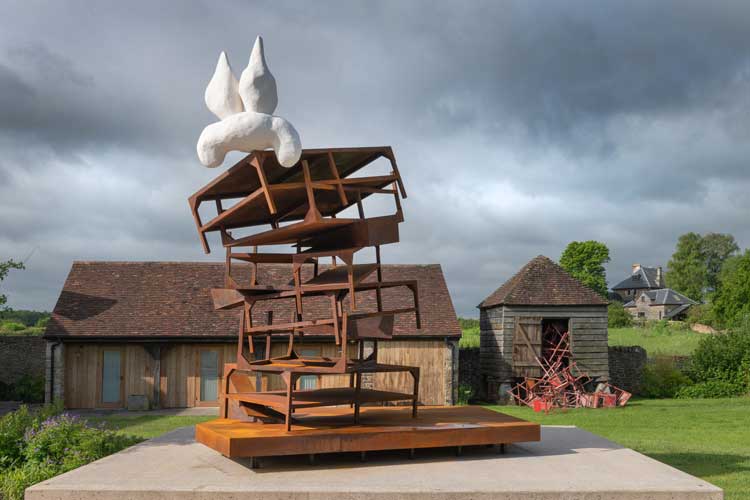
Installation view, Phyllida Barlow. Unscripted, Hauser & Wirth Somerset, 2024. © Phyllida Barlow Estate. Courtesy Phyllida Barlow Estate and Hauser & Wirth. Photo: Ken Adlard.
There are more faux rocks outside among courtyard grasses, while a series of seven large surreal steel, fibreglass and lacquer works are scattered across the gardens, the last studio pieces Barlow made before her death last year. But it is in smaller works where Morris’s curation perhaps offers more understanding. A room of maquettes and models brings real insight into Barlow’s process, presenting a joyous diligence of form-finding and material contorting.
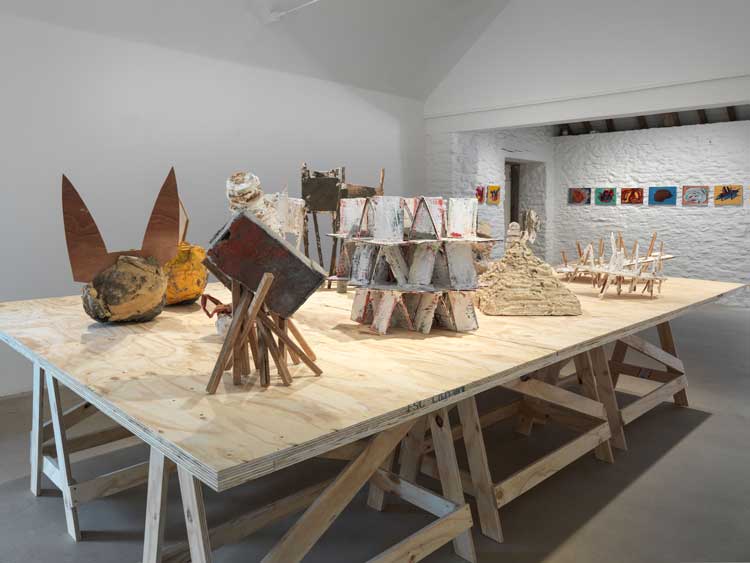
Installation view, Phyllida Barlow. Unscripted, Hauser & Wirth Somerset, 2024. © Phyllida Barlow Estate. Courtesy Phyllida Barlow Estate and Hauser & Wirth. Photo: Ken Adlard.
After the grandiosity, theatre and scale of some of the works on show, the journey ends in a simple salon hang of drawings. As with the models, these were evidently a critical part of Barlow’s process, and here are rightly celebrated in their own right and not solely as precursors to sculpture. Within the works are ideas or renders of many of the pieces only just seen within Hauser & Wirth’s sequence of spaces, while others tantalisingly suggest unknown and unmade possibilities. Just as within the sculptures, it is possible to read other artist’s lines, colours and energies in these drawings. Those interested in art history might glimpse Giorgio de Chirico, Paul Nash, Philip Guston or Pablo Picasso.
.jpg)
Installation view, Phyllida Barlow. Unscripted, Hauser & Wirth Somerset, 2024. © Phyllida Barlow Estate. Courtesy Phyllida Barlow Estate and Hauser & Wirth. Photo: Ken Adlard.
In these drawings, there are repeating motifs that can also be found in the works around Hauser & Wirth and over Barlow’s seven decades of making, including as Morris points out, elements of the unique space of sanctitude and self-reveal that is the home: “the bed, the locker, the window, the room – all interesting psychoanalytically”. But, Morris adds, Barlow “never wanted to interrogate her own background, but clearly there is a history and there were things in her past you can get little glimpses [of] when she talks about her family houses and domesticity”.
For all that Barlow’s work is about revealing and showing what’s behind the construction of a reality, many of the works are decoys, deceiving and concealing their interior. It’s a balancing act of openness, though this small room of Barlow’s drawings might offer the best key for the sculptural works – a coda to the exhibition, but one that opens more than it concludes.